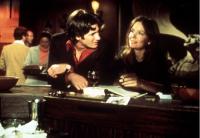Dead Finks Don’t Talk
 Last summer, I hardly went out at all. I was living at home, rent-free, in order so that I would be able to go out when I moved to New York. Every night, when I got home from work, my mother and I would watch the next movie in queue of her Netflix account. We always stick to the classics, because those are really the only movies worth watching. One night, she had a special surprise in store for me: Looking For Mr. Goodbar (1977).
Last summer, I hardly went out at all. I was living at home, rent-free, in order so that I would be able to go out when I moved to New York. Every night, when I got home from work, my mother and I would watch the next movie in queue of her Netflix account. We always stick to the classics, because those are really the only movies worth watching. One night, she had a special surprise in store for me: Looking For Mr. Goodbar (1977)."You’ll like it," she told me, "it has Diane Keaton."
"Oh! Like Annie Hall?"
"Kind of."
She’s a wily one, my mother. Yes, Looking For Mr. Goodbar stars Diane Keaton, as a single girl in New York, but Annie Hall it ain’t. Conversely, she plays the role of a young woman, Theresa, with loads of Freudian family drama crapping up her life. This, presumably, causes her to lead a dual existence: that of the kindergarten teacher by day and the hedonistic party girl at night. It would be a fun film to critique because Keaton portrays Theresa in such a way, that she is simultaneously sympathetic and galling, carrying the audience through an otherwise severely mottled plotline.
After moving out of her parents’ house, Theresa moves into the same apartment building as her sister (played by Tuesday Weld), where, after getting rejected by an older man, Theresa begins to lose interest in her job and focus instead on the seedy nightlife of Manhattan. This is 1977, so there’s a terribly outdated soundtrack and, because AIDS wasn’t even a mysterious rash yet, Theresa begins a downward spiral of sleeping with any man she can get. One of the men, in her string of one night stands, a very young Richard Gere, is even a bit fanatical, surprising Theresa at her apartment anytime he wants to get laid.
At its root, Looking For Mr. Goodbar is an anti-female film and if it didn’t have Diane Keaton in almost every scene, fluttering through the film as she does in each of her movies, it would be a total flop. Because the entire story is told from Theresa’s point of view, Keaton is presented with the task of providing her audience with a multilayered character, who deliberately pursues these men, in spite of the palpable harm inflicted upon her.
Directed by Richard Brooks, the master of the bitter and violent ending, Looking for Mr. Goodbar serves up a fairly predictable final scene: with Theresa bringing home the wrong suitor, on New Year’s Eve, and getting hacked to pieces while a strobe light throws slabs of florescent flashes onto the blood spattered walls of her studio apartment.
I don’t know if my mother was actually worried that her daughter was going to move to New York to become a huge slut, but this film served as her cautionary tale against such a lifestyle. No, I never had the intention of slutting it up all over Manhattan, but after seeing that ending, I was scared shitless of New York in general. I always liked Seattle and now even Nashville wasn’t looking so bad. The next night, when I returned from work, there were two movies for me to choose from: Annie Hall and Breakfast at Tiffany’s. I think that was my mom’s way of getting me out of her house and on my way to New York.

0 Comments:
Post a Comment
<< Home